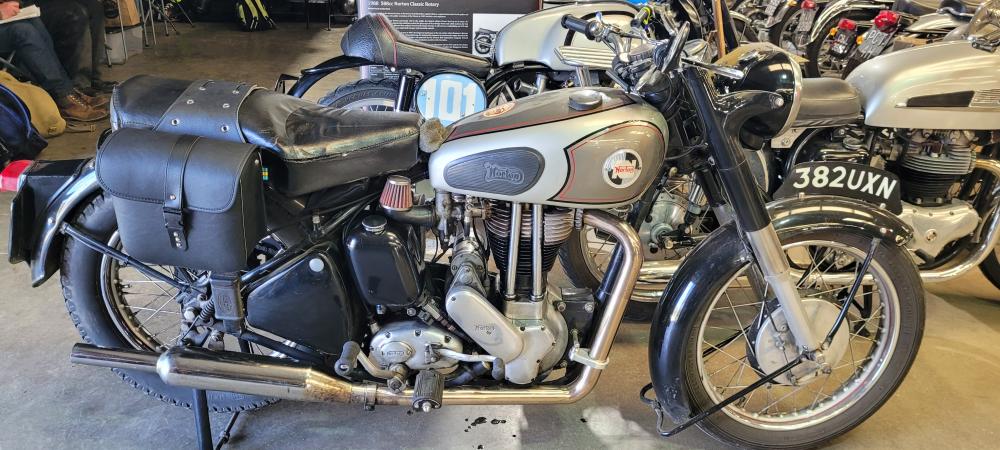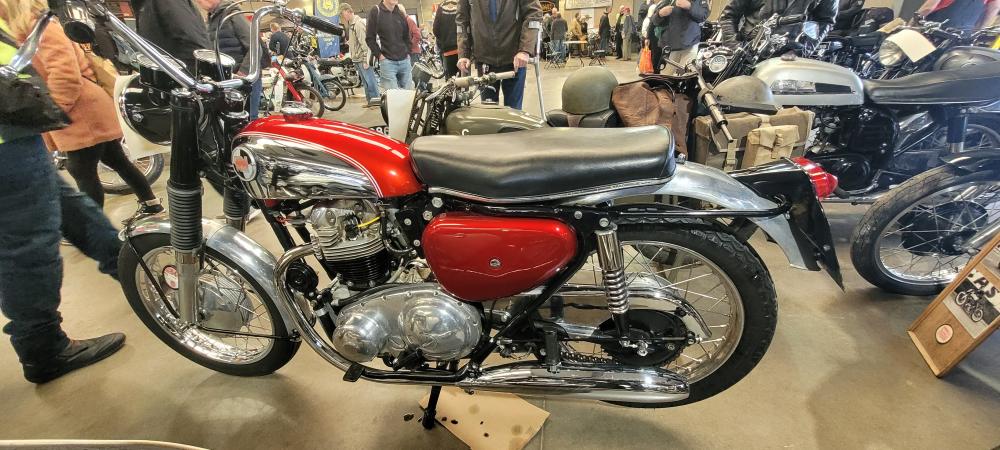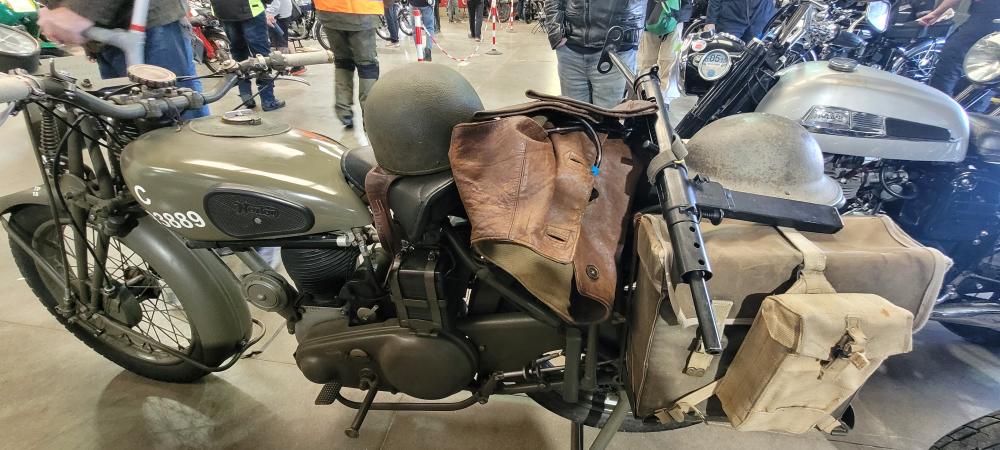John Hudson. Roadholder No. 181 - May/Jun 1996 and NOC-L
Remedies for smoking engines
"My 850 smokes a lot at tickover and on the overrun. I've replaced everything I can think of"
There is one very simple test to determine where the fault is. All you have to do is shut off completely the pressure oil feed to the cylinder head. Take out the banjo bolt which connects the rocker oil feed pipe to the back of the timing cover and let the pipe hang loose. Refit the bolt with a suitable spacer such as a 3/8" plain nut, replacing the banjo. You can now safely go for a run of 15 to 20 miles. If the smoking stops, the fault is in the cylinder head and nothing to do with the pistons, rings or cylinder bores. If this happens, there are two things to look for in the cylinder head:-
(1) The rocker shafts could have been replaced at some time the wrong way round. These should be plain steel without any oil scrolls and just one large flat with an oil exit hole in the centre. These must be positioned with the flat facing forwards in the exhaust rockers, that is away from the drilling in the rocker which feeds the pushrod. If they are positioned the other way round, as the scrolled shafts would be in an engine with low pressure feed, then the oil will rush down the pushrod end of the rocker and flood the head.
Check this as follows. Ride for a few miles to get the engine hot. Put the bike on the centre stand and remove the spark plugs, petrol tank and rocker caps. Engage top gear so the engine can be turned by the back wheel. Turn the engine very slowly and feel for approximate top dead centre with a rod inserted in the plug hole. Note on which side the rockers do not move. On the other side, both valves will be open and rocking as the engine is turned backward or forward.
On the side where the rockers are NOT moving, check that you can feel the tappet clearance and remove the setscrews and retaining plates from one rocker box. The rocker spindles themselves are threaded internally 5/16" x 26 t.p.i. (cycle thread) for extraction purposes. Obtain a bolt or setscrew with this thread and carefully screw it into the exposed end of the rocker spindle. Take particular care that the spindle does not turn as you do this. Watch the slot in the end, which should remain horizontal. The bolt only needs to screw in a few threads freely in order to try and pull the spindle out. Do not pull it right out, but only sufficiently to see whether the flat is facing left or right. Should it be found to be facing the wrong way then turn the spindle 180o, push it back home and refit the side plates and screws.
You can do this check with the engine cold, but it is unlikely you will be able to pull a spindle out without a nut and spacer on the bolt. A 3/8" square drive socket of at least 1/2" A.F. or 13mm will just pass over the end of the shaft and allow it to be pulled outwards.
Check all four shafts in turn. Do not turn the engine at all while a rocker spindle is removed and do not try to pull a spindle out unless you can feel the tappet clearance on the side on which you are working.
(2) The main cause of smoking on the 750s used to be oil passing down between the outside of the valve guide and the bore in which it fits in the head. Therefore the seals on top of the valve guides cannot stop this. It is indicated by a line of clean aluminium in the inlet port where the oil has run down, cleaning off the usual brown stain to be seen there. To remedy this, you need to take the head off and heat it to drive out the inlet guides, scrape a small radius or bevelled edge on the top of the guide bore, and refit the guides with Loctite which then makes a seal between the valve spring cup platform and the collar on the guide. By the time they made the 850s, they were using a larger diameter guide without a top flange but with a circlip to prevent the guide moving downwards. I have not heard of any 850s with this oiling problem.
(Editor's note - there is a third thing to look for while you are at it. Sometimes the seals come off the guides and go up and down with the valves. The stock seals are not a problem but the ones with little garter springs sometimes grip the valve stem tighter than they grip the guide). As for the pistons and rings, it is not really satisfactory to use the ring gap method to determine cylinder bore wear. From memory, an air-cooled engine should have a minimum gap of 0.003" per inch of cylinder bore diameter, so the 850 Norton would have a gap of 0.010" when new. Standard practice would have been to fit new rings when this gap increased to 0.020" in service. However, AE Autoparts (the people who used to make Hepolite pistons and rings) now say the gap could increase to almost twice this, 0.035" to 0.040", without detriment.
Smoking on one side only
|
|
I can think of only three possibilities:-
- A rocker arm shaft that's installed backwards on one side so the flat is is not pointed away from the center of the head, leading to over-oiling on that side
- A fragged (or missing) inlet-valve oil seal on one side
- Worn valve guides that somehow are showing visible smoke only on one side
Realistically, worn valve guides is the usual answer people give to this problem, but it would be nice to rule out the other possibilities before pulling the head. From the manual, it doesn't look as though the ends of the shafts are visibly different when oriented backwards, but I think you could check the orientation without disasembly by using a bent wire to feel for the drillway in the shaft where the flat is (or can you? I haven't tried it yet). However, I'm stumped at how one could check for the presence of an inlet valve seal without pulling the head and removing the valve springs.
Mike Taglieri (miketnyc@juno.com) on NOC-L 18th. Sep 1998
Smoking on one side could be an oval valve guide
Perhaps the bore in the head for the inlet valve guide is oval or otherwise damaged by a ham-fisted attempt to install new guides. It could well be that the oil is being sucked down along the outside of the inlet valve guide, which would of course be next to impossible to detect. If all else fails, have the guide bores reamed out for oversize guides and see if that helps.
John Hayduska (lists@benaco.com) on NOC-L 18th. Sep 1998
The Australian rope trick
Take the plug out and turn the motor to b.d.c. Feed a soft type rope in the chamber until its nearly full and then bring the motor to t.d.c. The rope now compressed should hold the the valve in place to check the oil stem seal. Once finished turn motor bak to b.d.c. and remove the rope.
Pete Combat (ipdream@nettrade.com..au) on NOC-L 18th. Sep 1998
Sealing valve guides with silicone rubber
Les Emery tipped me off that most heads have defective guide holes, and that they should always be coated with Loctite or gasket goo when installing new ones to ensure a gas tight seal; even reamed holes need to be sealed as well. It cured my smoking Dommie when I knocked out my new guides and reinstalled them with Loctite Thread Lock 242.
Alternatively you could try the quick fix that has worked for me in the past:-
- Do the rope trick
- Remove the valve cap, springs etc.
- Stick the bottom washers to the head with silicone sealant round the guide base to seal the gaps
- Reassemble and let it set
It lasts for ages and could prove if in fact guide leaks are the problem.
Angelo (rubberboy@dial.pipex.com) on NOC-L 18th. Sep 1998








